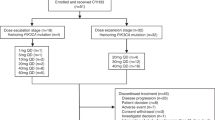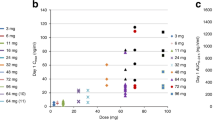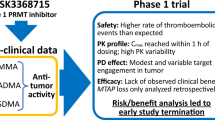Abstract
Cytochrome P450-based gene therapy can substantially increase the sensitivity of tumor cells to P450-activated cancer chemotherapeutic prodrugs such as cyclophosphamide (CPA) without increasing host toxicity. While the role of 4-OH-CPA, the primary active metabolite of CPA, in eliciting tumor cell death is well established, the effect of 4-OH-CPA exposure on the capacity of P450-expressing tumor cells for continued metabolism and activation of CPA has not been investigated. The present study addresses this question and characterizes the impact of CPA dose and treatment schedule on the ability of P450-expressing tumor cells to sustain prodrug activation over time. 9L gliosarcoma cells expressing human P450 2B6 and treated with CPA in a continuous manner exhibited a time- and CPA dose-dependent decrease in P450-catalyzed CPA 4-hydroxylase activity. This decrease reflects a selective, 4-OH-CPA-induced loss of cellular P450 protein content. By contrast, when the P450-expressing tumor cells were treated with CPA as a single 8 hours exposure, cellular CPA 4-hydroxylase activity and P450 protein expression were substantially prolonged when compared to continuous prodrug treatment. This schedule-dependent effect of CPA was influenced by the level of P450 protein expressed in the tumor cells. At high P450 protein and activity levels, which could be achieved by culturing the tumor cells at high cell density, net production and release of 4-OH-CPA into the culture media was increased substantially. This increase fully offset the decline in CPA 4-hydroxylase activity as the tumor cells underwent CPA-induced apoptotic death. These findings demonstrate the impact of CPA dose and treatment schedule on the efficacy of P450 gene-directed enzyme prodrug therapy, with bolus CPA treatment being compatible with sustained expression of P450 protein and maintenance of P450-dependent prodrug activation by the target tumor tissue.
This is a preview of subscription content, access via your institution
Access options
Subscribe to this journal
Receive 12 print issues and online access
$259.00 per year
only $21.58 per issue
Buy this article
- Purchase on Springer Link
- Instant access to full article PDF
Prices may be subject to local taxes which are calculated during checkout








Similar content being viewed by others
Abbreviations
- P450:
-
cytochrome P450
- CPA:
-
cyclophosphamide
- 4-OH-CPA:
-
4-hydroxy-cyclophosphamide
- GDEPT:
-
gene-directed enzyme prodrug therapy
- 9L/P450 cells:
-
9L gliosarcoma cells that stably express human P450 2B6 and human P450 reductase
- AUC:
-
area under the curve
References
Sladek NE . Metabolism of oxazaphosphorines. Pharmacol Ther. 1988;37:301–355.
Chen L, Waxman DJ . Cytochrome P450 gene-directed enzyme prodrug therapy (GDEPT) for cancer. Curr Pharmaceut Des. 2002;8:1405–1416.
Wei MX, Tamiya T, Chase M, et al. Experimental tumor therapy in mice using the cyclophosphamide-activating cytochrome P450 2B1 gene. Hum Gene Ther. 1994;5:969–978.
Chen L, Waxman DJ . Intratumoral activation and enhanced chemotherapeutic effect of oxazaphosphorines following cytochrome P-450 gene transfer: development of a combined chemotherapy/cancer gene therapy strategy. Cancer Res. 1995;55:581–589.
Jounaidi Y, Hecht JE, Waxman DJ . Retroviral transfer of human cytochrome P450 genes for oxazaphosphorine-based cancer gene therapy. Cancer Res. 1998;58:4391–4401.
Jounaidi Y, Waxman DJ . Frequent, moderate dose cyclophosphamide administration improves the efficacy of P450/P450 reductase-based cancer gene therapy. Cancer Res. 2001;61:4437–4444.
Kan O, Griffiths L, Baban D, et al. Direct retroviral delivery of human cytochrome P450 2B6 for gene-directed enzyme prodrug therapy of cancer. Cancer Gene Ther. 2001;8:473–482.
Ichikawa T, Petros WP, Ludeman SM, et al. Intraneoplastic polymer-based delivery of cyclophosphamide for intratumoral bioconversion by a replicating oncolytic viral vector. Cancer Res. 2001;61:864–868.
Pawlik TM, Nakamura H, Yoon SS, et al. Oncolysis of diffuse hepatocellular carcinoma by intravascular administration of a replication-competent, genetically engineered herpesvirus. Cancer Res. 2000;60:2790–2795.
Griffiths L, Binley K, Iqball S, et al. The macrophage – a novel system to deliver gene therapy to pathological hypoxia. Gene Therapy 2000;7:255–262.
Lohr M, Muller P, Karle P, et al. Targeted chemotherapy by intratumour injection of encapsulated cells engineered to produce CYP2B1, an ifosfamide activating cytochrome P450. Gene Therapy. 1998;5:1070–1078.
Lohr M, Hoffmeyer A, Kroger J, et al. Microencapsulated cell-mediated treatment of inoperable pancreatic carcinoma. Lancet. 2001;357:1591–1592.
Schwartz PS, Waxman DJ . Cyclophosphamide induces caspase 9-dependent apoptosis in 9L tumor cells. Mol Pharmacol. 2001;60:1268–1279.
Ayash LJ, Wright JE, Tretyakov O, et al. Cyclophosphamide pharmacokinetics: correlation with cardiac toxicity and tumor response. J Clin Oncol. 1992;10:995–1000.
Dorr RT, Van Hoff DD . Cancer Chemotherapy Handbook, 2nd ed. Norwalk, CT: Appleton & Lange; 1994: p. 319–328.
Juma FD, Rogers HJ, Trounce JR. The pharmacokinetics of cyclophosphamide, phosphoramide mustard and nor-nitrogen mustard studied by gas chromatography in patients receiving cyclophosphamide therapy. Br J Clin Pharmacol. 1980;10:327–335.
Juma FD, Rogers HJ, Trounce JR . Effect of renal insufficiency on the pharmacokinetics of cyclophosphamide and some of its metabolites. Eur J Clin Pharmacol. 1981;19:443–451.
Sladek NE, Doeden D, Powers JF, et al. Plasma concentrations of 4-hydroxycyclophosphamide and phosphoramide mustard in patients repeatedly given high doses of cyclophosphamide in preparation for bone marrow transplantation. Cancer Treat Rep. 1984;68:1247–1254.
Chen L, Yu LJ, Waxman DJ . Potentiation of cytochrome P450/cyclophosphamide-based cancer gene therapy by coexpression of the P450 reductase gene. Cancer Res. 1997;57:4830–4837.
Pope IM, Poston GJ, Kinsella AR . The role of the bystander effect in suicide gene therapy. Eur J Cancer. 1997;33:1005–1016.
Huang Z, Waxman DJ . High-performance liquid chromatographic-fluorescent method to determine chloroacetaldehyde, a neurotoxic metabolite of the anticancer drug ifosfamide, in plasma and in liver microsomal incubations. Anal Biochem. 1999;273:117–125.
Roy P, Yu LJ, Crespi CL, et al. Development of a substrate-activity based approach to identify the major human liver p-450 catalysts of cyclophosphamide and ifosfamide activation based on cdna-expressed activities and liver microsomal p- 450 profiles. Drug Metab Dispos. 1999;27:655–666.
Huang Z, Roy P, Waxman DJ . Role of human liver microsomal CYP3A4 and CYP2B6 in catalyzing N-dechloroethylation of cyclophosphamide and ifosfamide. Biochem Pharmacol. 2000;59:961–972.
Gurtoo HL, Marinello AJ, Struck RF, et al. Studies on the mechanism of denaturation of cytochrome P-450 by cyclophosphamide and its metabolites. J Biol Chem. 1981;256:11691–11701.
Schwartz PS, Chen CS, Waxman DJ . Enhanced bystander cytotoxicity of P450 gene-directed enzyme prodrug therapy by expression of the antiapoptotic factor p35. Cancer Res. 2002;62:6928–6937.
D'Incalci M, Bolis G, Facchinetti T, et al. Decreased half life of cyclophosphamide in patients under continual treatment. Eur J Cancer. 1979;15:7–10.
Bocci G, Nicolaou KC, Kerbel RS . Protracted low-dose effects on human endothelial cell proliferation and survival in vitro reveal a selective antiangiogenic window for various chemotherapeutic drugs. Cancer Res. 2002;62:6938–6943.
Man S, Bocci G, Francia G, et al. Antitumor effects in mice of low-dose (metronomic) cyclophosphamide administered continuously through the drinking water. Cancer Res. 2002;62:2731–2735.
Browder T, Butterfield CE, Kraling BM, et al. Antiangiogenic scheduling of chemotherapy improves efficacy against experimental drug-resistant cancer. Cancer Res. 2000;60:1878–1886.
Chen TL, Kennedy MJ, Anderson LW, et al. Nonlinear pharmacokinetics of cyclophosphamide and 4-hydroxycyclophosphamide/aldophosphamide in patients with metastatic breast cancer receiving high-dose chemotherapy followed by autologous bone marrow transplantation. Drug Metab Dispos. 1997;25:544–551.
Chan KK, Hong PS, Tutsch K, et al. Clinical pharmacokinetics of cyclophosphamide and metabolites with and without sr-2508. Cancer Res. 1994;54:6421–6429.
Anderson LW, Chen TL, Colvin OM, Grochow LB, Collins JM, Kennedy MJ, Strong JM . Cyclophosphamide and 4-Hydroxycyclophosphamide/aldophosphamide kinetics in patients receiving high-dose cyclophosphamide chemotherapy. Clin Cancer Res. 1996;2(9):1481–1487.
Wu FJ, Friend JR, Remmel RP, et al. Enhanced cytochrome P450 1A1 activity of self-assembled rat hepatocyte spheroids. Cell Transplant. 1999;8:233–246.
Tzanakakis ES, Hsiao CC, Matsushita T, et al. Probing enhanced cytochrome P450 2B1/2 activity in rat hepatocyte spheroids through confocal laser scanning microscopy. Cell Transplant. 2001;10:329–342.
Hamilton GA, Jolley SL, Gilbert D, et al. Regulation of cell morphology and cytochrome P450 expression in human hepatocytes by extracellular matrix and cell–cell interactions. Cell Tissue Res. 2001;306:85–99.
Acknowledgements
This work was supported in part by NIH grant CA49248 (to DJW).
Author information
Authors and Affiliations
Corresponding author
Rights and permissions
About this article
Cite this article
Schwartz, P., Chen, CS. & Waxman, D. Sustained P450 expression and prodrug activation in bolus cyclophosphamide-treated cultured tumor cells. Impact of prodrug schedule on P450 gene-directed enzyme prodrug therapy. Cancer Gene Ther 10, 571–582 (2003). https://doi.org/10.1038/sj.cgt.7700601
Received:
Published:
Issue Date:
DOI: https://doi.org/10.1038/sj.cgt.7700601



